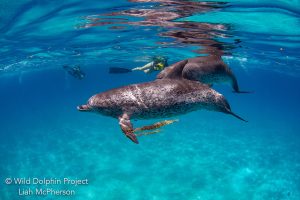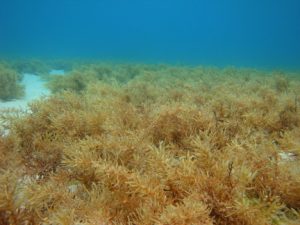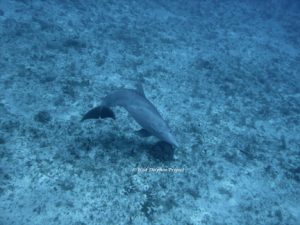Be sure to check out all of the blogs in this rare behavior series (Can anyone hear me, Pesky Remoras, Bottom Behavior, Bubbles, Synchrony).The dolphins that we study in the Bahamas are often observed over sandy stretches of habitat. Over the decades we have observed some rare behavior and use of the bottom during dolphin activity, both for spotted dolphins and bottlenose dolphins. Here are a few examples.
Rare Behavior Blog #3
A Shallow Water Bottom Full of Food and Fun
Denise L. Herzing and Cassie L. Volker
The Original Loofa
There are many species of sargassum (Sargassum sp.). Both the Atlantic spotted dolphins and bottlenose dolphins like to play with floating sargassum weed that we see in the Bahamas (Sargassum fluitans). They use it as a toy and they may also use it to scratch and rub their skin. They regularly play games of “keep away” with each other and mothers teach their calves the proper etiquette of this game.
We have also observed dolphins moving through a floating sargassum patch as if it feels good rubbing over their skin. The bottlenose dolphins also use benthic sargassum, as well as a variety of sponges, (Family Demospongiae) to rub on. These dolphins appear to be using the sponges and benthic sargassum algae to scratch and rub their bodies, either for health and/or pleasure.
An underwater fish-finding tornado tool
We often observe bottlenose dolphins swimming close to the bottom, scanning as they swim, and lightly tapping their tails and pectoral fins during crater feeding activity. In one rare observation, in 1995 while recording this behavior on the bottom, the camera caught the creation of a sand-filled vortex after a bottlenose dolphin tapped the bottom while swimming by. The vortex, or sand tornado (only visible because of the sand in it), moved towards a fish hole, and the dolphin moved over to the vortex and dug for a fish. The physics of a vortex is such that it will move towards an area of low pressure, such as a hole. This may indicate that the dolphin was actually creating a tool to help it search for and mark/identify a fish hole. Wow! Such vortices may easily exist in the water without being visible to a human observer, and only when sand filled the vortex were we able to observe it. This would be the first such observation of a dolphin creating a tool, via the manipulation of water action, for foraging purposes. Dolphins have been observed easily manipulating water and creating bubble rings both through the expulsion of air from their blowhole, as well as the rapid movement of their dorsal fin and body in a small tank, creating a bubble that they then use as a toy. So, it appears that dolphins are master manipulators of water in many ways.
In this video clip you can see the sand vortex created by the pectoral fin of a bottlenose dolphin to locate a fish hole.
Hunting Under Reef Ledges with Nurse Sharks
We often observe bottlenose dolphins scanning the sandy bottoms for buried fish. During this activity the dolphins are in close proximity to nurse sharks, who also dig in the sand for fish and crustaceans…But what else do these two species do in close proximity? We had a very rare observation in 2010 of a group of bottlenose dolphins foraging, sometimes upside-down, under a densely packed area of small coral heads. The dolphins were often observed on the same coral head with a few nurse sharks, sometimes prodding underneath at the same time. These ledges were later explored and contained densely-packed snappers and lobsters, a feast for anyone.
In this video clip you can see Bottlenose dolphins and nurse sharks hunting under a ledge for food. At :10 seconds you can see the dolphins chase after a fish that comes out from underneath a rock. At :53 seconds, you can see the bottlenose dolphins and nurse sharks all around the same rock.
For more detailed reading see:
Pace, D. S. (2000). Fluke-made bubble rings as toys in bottlenose dolphin calves
(Tursiops truncatus). Aquatic mammals, 26(1), 57-64.
Rossbach, K. A., & Herzing, D. L. (1997). Underwater observations of benthic‐feeding
bottlenose dolphins (Tursiops truncatus) near Grand Bahama Island, Bahamas.
Marine Mammal Science, 13(3), 498-504. https://doi.org/10.1111/j.1748-7692.1997.tb00658.x
Ying, S. J., & Chang, C. C. (1970). Exploratory model study of tornado-like vortex
dynamics. Journal of Atmospheric Sciences, 27(1), 3-14.
https://doi.org/10.1175/1520-0469(1970)027<0003:EMSOTL>2.0.CO;2



